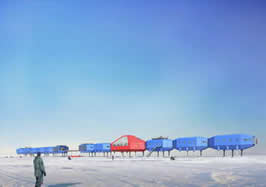Local Architect wins international competition to build ice station
| Related Links | |
Architect's image of Halley VI ice station |
|
| Participate | |
| Sign up for our free weekly newsletter Comment on this story on the |
Chiswick resident, Hugh Broughton, and his consortium have won an international competition to build a new ice station in Antarctica. Designed to cope with one of the most inhospitable environments on Earth, the proposed structure will resemble a giant blue centipede.
British Antarctic Survey's Halley VI station will not only be on a floating ice shelf that will flow out to sea and break up, but it will host scientists all year long in temperatures that range from minus 5 degrees to minus 40 degrees Centigrade (23 degrees to minus 40 degrees Fahrenheit).
The winning design, by the Faber Maunsell and Hugh Broughton Architects consortium, consists of a long, segmented body held high off the ground by adjustable legs on skis so it can be periodically towed back towards land.
It beat off designs from two other finalists, one of which was for a "walking" building and the other for a building that appeared to hover on legs above the ice.
"This was an incredibly tough choice for the jury panel to make," BAS director Chris Rapley told Reuters "The process ... was stimulating and exciting for everyone involved."
The design specifications for the £19 million ($33 million) ice station on the Brunt ice shelf are among the most exacting on the planet. It must it be home to a crew of scientists that dwindles to 16 in the southern hemisphere winter when there is no daylight for three months and booms to 60 in the summer months, and it has to rise above the 1.5 metres of snow that falls each year.
At the same time every nut and bolt must be shipped in and, when the station comes to the end of its anticipated 20-year life, everything must be shipped out again to leave no trace of its existence on the pristine continent. Four of the previous Halley ice stations dating back to the 1950s have slowly been buried by the snow and crushed by the ice as it travels northwest at the rate of 400 metres a year and gradually breaks up at its seaward edge.
The Halley V station it will replace by December 2008 also has adjustable legs and is the only one not to have been buried. However, it faces another problem. Scientists predict that the ice shelf will halve within the next decade and the section of ice on which Halley V sits will simply float away. The new, towable ice station should be able to avoid such problems by simply moving out of the danger area, allowing scientists to carry on vital research at the site where the hole in the ozone layer was first discovered.
During an interview for BBC's Today programme Hugh Broughton explained that a two storey climbing wall is planned to keep the resident scientists fit and entertained. The structure also has the capability to grow salads hydroponically, providing nutrious salads up to 3 times a week.
May 5, 2005
